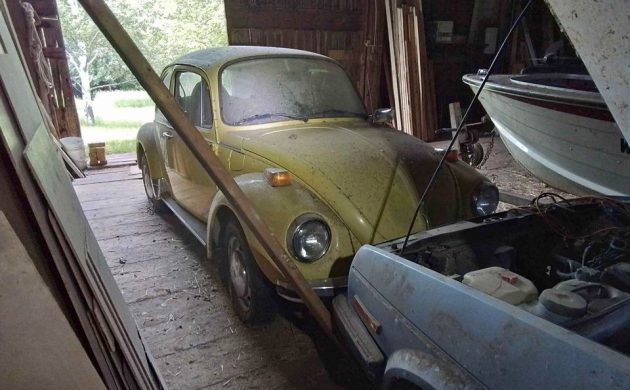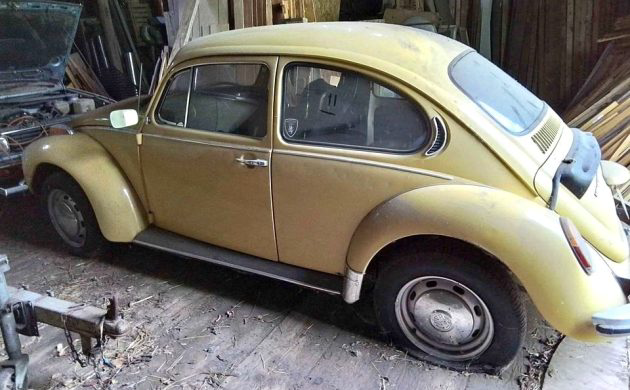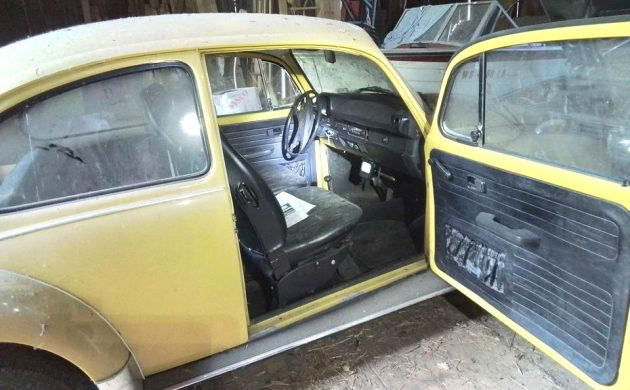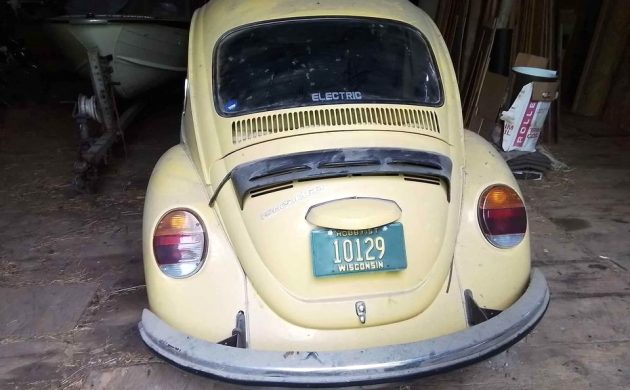Volkswagen introduced the Super Beetle in 1971 to give dealers more choices for U.S. buyers. The Super Beetle varied from the standard Beetle by its curved windshield, larger luggage space, and McPherson front strut suspension. But none of them had what the seller’s Type 1 has – electric power. This 1973 Super Beetle was converted to run on electric juice, perhaps long before it started to become the norm in some circles. We’re told that everything is still there to go back to gasoline propulsion if you wish. A tip brought to us by “Lothar… of the Hill People”.
We’re not told when, where, or how this conversion took place. There are no photos of the electric motor or the variety of batteries that no doubt were needed. From the looks of things, this “E-Bug” has been in storage for some time and wears a layer of dust. No mention is made as to whether it runs or what it would take to run again. Was this an experiment that simply didn’t pan out?
What we do know is this Beetle originated in California and is in Appleton, Wisconsin now. The body appears to be in great shape and rust may not be an issue. We hope the interior is okay, but the photos don’t do a deep dive. If you were going to go back to stock, we assume the 1,600-cc air-cooled engine that once powered this Beetle is somewhere in the garage.
This could be a very interesting Type 1 to peddle if the seller had chosen to focus on the electric conversion. Now, it sounds like an old Beetle that might be better served going back to its roots. Whatever the case, this VW is available here on Facebook Marketplace for $5,000 or the best “reasonable” offer. E-Bug or Gas-Bug, which would you choose?






Even if it’s powered by gerbils I wouldn’t even go look at a dirty car in a dirty barn with flat tires.
My opinion is that electrification was a big failure, why else would it be in a barn, covered by barn dust?. Even if they still had the original running gear, a very big fat no.
Kudos for trying but an easy pass. Too many still out there with the original air-cooled (ddddddddd-sounding) engine.
So would this be a Voltswagen?
Now that was funny!!
Yes. A dirty, dusty, no charged, flat tired uncharged Voltwagen.
you can buy running driving beetles for less than that, I wouldnt be interested even with the original powerplant packaged beside it.
Correction to the article. Yes the Super Beetle was introduced for the 71 model year with improved riding McPherson struts but it still retained the standard Beetle flat windshield and dash. 73 was the first year for the curved windshield, larger bumpers and tail lamps to satisfy federal regulations, and a redesigned dashboard. In 75 the Super Beetle got rack and pinion steering which quelled the death wobble nature of the old steering box design.
As far as this car is concerned it looks to be free of rust in the heater channels. If the frame head check out and you have the original engine it’s worth it to throw the conversion crap in the bin. Not for 5K though but 3K if it checks out.
I wonder if any of the VW’ers have tried backdating these, like the Porsche folks do?
For the old headlights and smaller bumpers. yes.
Need to see more of the Mk2…
Joe DiMaggio?
I always look at things like this with the attitude what can I flip it for. Add in the cost of going to get it I’m not sure about this electric conversation thing so taking it back to stock would cost more money and time. I have some other ideas about a completely different power plant for it but don’t know if it would work until I got it home and got it on a lift with a tape measure. So I think I will pass on this one far to many unknown things
I believe it’s the Bundy family’s garage
I would bet that’s it is an old conversion with out of date electrics and batteries. I would purchase one of the many, modern pre-made VW conversion kits, and replace the entire home-brew system, after getting a substantial discount from the listed price
You might think they would at least consider opening the hood so you could see what you’re up against. $6000 if he put the motor in and made it run would still be a stretch.
Electric conversions were popular before commercial electric vehicles became available, and several companies sold complete kits. It would be interesting to know if this was a kit or home made. Conversions usually occurred after a vehicle failed the California smog test. Small lightweight cars that failed could be picked up for almost nothing.